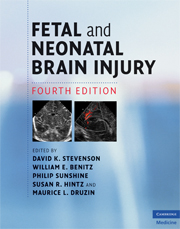Book contents
- Frontmatter
- Contents
- List of contributors
- Foreword
- Preface
- Section 1 Epidemiology, pathophysiology, and pathogenesis of fetal and neonatal brain injury
- Section 2 Pregnancy, labor, and delivery complications causing brain injury
- Section 3 Diagnosis of the infant with brain injury
- 16 Clinical manifestations of hypoxic–ischemic encephalopathy
- 17 The use of EEG in assessing acute and chronic brain damage in the newborn
- 18 Neuroimaging in the evaluation of pattern and timing of fetal and neonatal brain abnormalities
- 19 Light-based functional assessment of the brain
- 20 Placental pathology and the etiology of fetal and neonatal brain injury
- 21 Correlations of clinical, laboratory, imaging, and placental findings as to the timing of asphyxial events
- Section 4 Specific conditions associated with fetal and neonatal brain injury
- Section 5 Management of the depressed or neurologically dysfunctional neonate
- Section 6 Assessing outcome of the brain-injured infant
- Index
- Plate section
- References
19 - Light-based functional assessment of the brain
from Section 3 - Diagnosis of the infant with brain injury
Published online by Cambridge University Press: 12 January 2010
- Frontmatter
- Contents
- List of contributors
- Foreword
- Preface
- Section 1 Epidemiology, pathophysiology, and pathogenesis of fetal and neonatal brain injury
- Section 2 Pregnancy, labor, and delivery complications causing brain injury
- Section 3 Diagnosis of the infant with brain injury
- 16 Clinical manifestations of hypoxic–ischemic encephalopathy
- 17 The use of EEG in assessing acute and chronic brain damage in the newborn
- 18 Neuroimaging in the evaluation of pattern and timing of fetal and neonatal brain abnormalities
- 19 Light-based functional assessment of the brain
- 20 Placental pathology and the etiology of fetal and neonatal brain injury
- 21 Correlations of clinical, laboratory, imaging, and placental findings as to the timing of asphyxial events
- Section 4 Specific conditions associated with fetal and neonatal brain injury
- Section 5 Management of the depressed or neurologically dysfunctional neonate
- Section 6 Assessing outcome of the brain-injured infant
- Index
- Plate section
- References
Summary
Introduction
Jobsis first described the measurement of cerebral oxyhemoglobin saturation using near-infrared spectroscopy (NIRS) in 1977. This work was immediately recognized for its profound clinical implications, especially in the neonatal arena, and the search for the ideal neurologic neonatal monitor began. In 1985, when the NIROS-SCOPE was used on three infants in the neonatal intensive care unit (NICU) at Duke University, Brazy et al. made the following claim:
For effective measurement of cerebral oxygen sufficiency in a sick newborn, an instrument should be non-invasive, be adaptable at the bedside, not interfere with patient care, and give continuous rapid information. The signals should directly assess brain oxygen delivery and utilization and be sensitive to small changes. The NIROS-SCOPE appears to fulfill these basic requirements.
Available for many years, NIRS-based monitors of cerebral oxygenation have held the promise to fill the gap in neonatal neuromonitoring, but at this writing they are neither standard of care nor ubiquitous. Signs point to increased marketing of NIRS-based cerebral oximetry monitors to healthcare facilities in the United States, particularly to NICUs. In an effort to prepare clinicians for this impending deployment, we summarize in this chapter three decades of work done with NIRS to develop the cerebral oximeters available today.
Some view NIRS-based cerebral oximetry as purely an investigational tool. However, it is noteworthy that (1) the cerebral oximeter is frequently employed in the congenital cardiac surgical arena at major medical centers, and (2) competing companies have marketed cerebral oximeters that have been approved by the United States Food and Drug Administration (FDA).
- Type
- Chapter
- Information
- Fetal and Neonatal Brain Injury , pp. 232 - 239Publisher: Cambridge University PressPrint publication year: 2009



